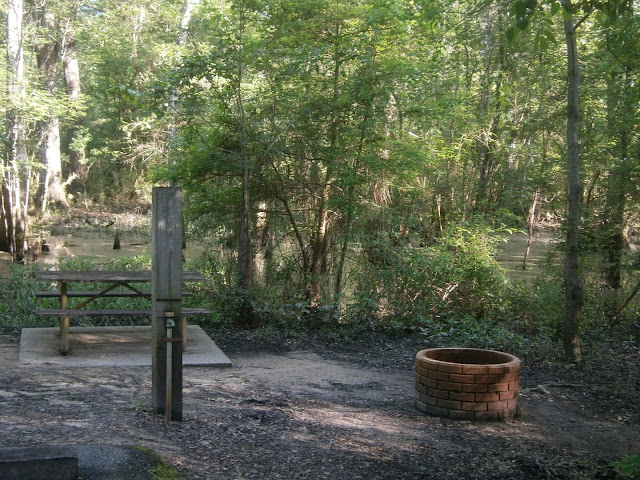Living in a journey is fascinating. There are very few routines
apart from the ones that are self imposed. Scenery and habitat never, ever
repeat. And truly, one never knows what to next expect .
Rain splatter woke me up at 5:00. It didn’t amount to
anything, but of course I didn’t know that, so to be prudent I thought it was
best to get up and pack while everything was dry. By the time I finished the
sun was up in a clear sky.
But then I noticed this:
 |
| Oh. That can't be good. |
With hopeful excitement, the buzzards returned and sat
around waiting to see if I would manage to get myself out of this one. It is
fair to say I shared their curiosity.
 |
| The Buzzard Boys are ever hopeful. |
With no air pump and of course no spare tire I suddenly felt
quite at the mercy of circumstance. After a tour of the campground I found that
the caretaker had a pump to at least get me on the road. After doing a little
leak test I determined that the leak was slow enough for an injection of air to last me until I got to
town, so I pumped it up to 45 psi and made haste. Bridgeport (which is not a port, nor does it
have a bridge) is a little town with no tire shop. Although it does have a
muffler shop. So I says to the mechanic, “If you had a motorcycle with a flat
tire, where would you take it to in this town?” And he says, “why, right here,
sir”. And so he fixed it. He pulled a thorn out of The Bruiser’s foot that
might have been imbedded for some time, just waiting for the tire to wear down
far enough to puncture the inner tube. My guess is that it came from the
landfill-style campsite that I enjoyed near El Paso.
So I’m back rollin’ thunder by 10:00 after wondering just a
couple hours earlier how I was ever going to get on the road at all. Ya never
know.
This epic journey was billed as a solo trip. You know I
really thought I was traveling alone. But that, as it turns out, is quite
impossible. Without the generous help of so many local people I have met along
the way I would never have gotten this far. I am grateful to them all,
including my dear family and friends who have been zapping me messages every
day that keeps me feeling encouraged and cared about.
I thank you.
In due course The Bruiser and I got ourselves out of Texas and crossed into Oklahoma north on 44 (sort of). The landscape quickly
changed to pastoral farmland with oceans of green pasture over which the wind
whipped waves and ripples. Later in the day the sun reflecting off the tops of
the grass gave the impression of whitecaps on stormy seas. Emerald grasses are
broken with patches of brick red soil and creek beds and with dense carpets of
yellow flowers.
 |
| The Bruiser arrives in Oklahoma |
 |
| Rocks and mountains! I missed them. |
And mountains! And Rocks! Hwy 49 leads through the Witchita
Mountain Wildlife Refuge. My motive was to break up the flat and straight
highway travel that has made driving feel more like aiming than steering for
most of the last week or two. But I wasn’t prepared for buffalo!
These prairie towns are small and don’t always offer much
for services. All too frequently they have shrunk to nearly nothing. Roosevelt is a classic example of commercial atrophy.
Every single store along the main drag is closed and rotting, even although the
surrounding area has quite a number of healthy looking homes and ranches.
Curiously, road crews were repaving the main street! There is a story here, I
am certain of it.
 |
| Downtown Roosevelt, Oklahoma |
I was stopped at the roadside checking my maps as I so
frequently do, when a truck pulled alongside and a fellow asked if I needed
help. His useful advice on the local geography also came with a colour
commentary.
“There is a Rattlesnake Festival at Magnum this weekend”, he
says.
“Is that good?” I asked.
“You bet! I’m bringing Billy!” And with that he holds his
pet boa constrictor aloft that had been resting in a cage on his front seat.
This is an event that should not be missed. Apparently there
are also flea markets and corn dogs.
We’re camping tonight at the State Park on Lake Tom Steed
and were fortunate to have scored waterfront property on the lake. Water level
is low in the lake following an extended period of drought and it is predicted
to continue through the summer. Unseasonably hot and humid weather prevails in
this part of Oklahoma
this week and the bugs have all filed flight plans for here. Bird sounds are continuous
and quite delightful. Wrens have a distinctive sound that someone pointed out
to me when I was in Big Bend, and I have since
noticed that their songs have slightly different dialects in each place that I
have been. As do the checkout clerks at the convenience stores!
 |
| Lookin' out my back door |
As I am sitting at my little picnic table writing this draft
in the dark, my neighbour came over with a plate of dinner for me. It was as
delicious as it was gracious! Thank you Tracy!
Much has been said about southern hospitality, but not nearly enough!










































